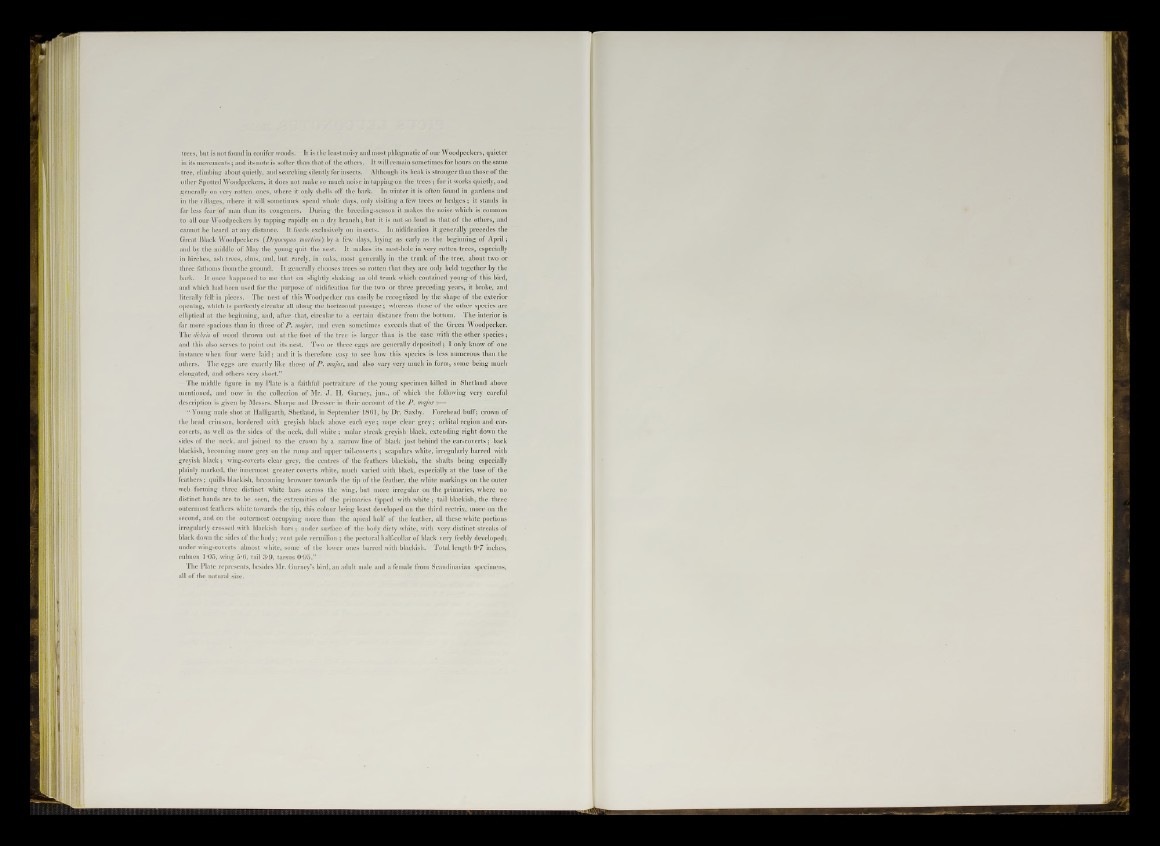
trees, but is not found in conifer woods. It is the least noisy and most phlegmatic of our Woodpeckers, quieter
in its movements ; and its note is softer than that of the others. It will remain sometimes for hours on the same
tree, climbing about quietly, and searching silently for insects. Although its beak is stronger than those of the
other Spotted Woodpeckers, it does not make so much noise in tapping on the trees ; for it works quietly, and
generally on very rotten ones, where it only shells off the bark. In winter it is often found in gardens and
in the villages, where it will sometime^ spend whole days, only visiting a few trees or hedges ; it stands in
far less fear of man than its congeners. During the breeding-season it makes the noise which is common
to all our Woodpeckers by tapping rapidly on a dry branch ; but it is not so loud as that of the others, and
cannot he heard at any distance. It feeds exclusively on insects. In nidification it generally precedes the
Great Black Woodpeckers (Drtjocopus martius) by a few days, laying as early as the beginning of April ;
and by the middle of May the young quit the nest. It makes its nest-hole in very rotten trees, especially
in birches, ash trees, elms, and, but rarely, in oaks, most generally in the trunk of the tree, about two or
three fathoms from the ground. It generally chooses trees so rotten that they are only held together by the
bark. It once happened to me that on slightly shaking an old truuk which contained young of this bird,
and which had been used for the purpose of nidification for the two or three preceding years, it broke, and
literally fell in pieces. The nest of this Woodpecker can easily be recognized by the shape of the exterior
opening, which is perfectly circular all along the horizontal passage ; whereas those of the other species are
elliptical at the beginning, and, after that, circular to a certain distance from the bottom. The iuterior is
far more spacious than in those of P. major, and even sometimes exceeds that of the Green Woodpecker.
The débris of wood thrown out at the foot of the tree is larger than is the case with the other species ;
and this also serves to point out its nest. Two or three eggs are geiicrally deposited ; I only know of one
instance when four were laid ; and it is therefore easy to see how this species is less numerous than the
others. The eggs are exactly like those of P. major, and also vary very much in form, some being much
elongated, and others very short.”
The middle figure in my Plate is a faithful portraiture of the young specimen killed in Shetland above
mentioned, and now in the collection of Mr. J . H. Gurney, jun., of which the following very careful
description is given by Messrs. Sharpe and Dresser in their account of the P. major :■—
“ Young male shot at Halligarth, Shetland, in September 1861, by Dr. Saxby. Forehead buff; crown of
the head crimson, bordered with greyish black above each eye ; nape clear grey ; orbital region and ear-
coverts, as well as the sides of the neck, dull white ; malar streak greyish black, extending right down the
sides of the neck, and joined to the crown by a narrow line of black just behind the ear-coverts ; back
blackish, becoming more grey on the rump and upper tail-coverts ; scapulars white, irregularly barred with
greyish black ; wing-coverts clear grey, the centres of the feathers blackish, the shafts being especially
plainly marked, the innermost greater coverts white, much varied with black, especially at the base of the
feathers ; quills blackish, becoming browner towards the tip of the feather, the white markings on the outer
web forming three distinct white bars across the wing, but more irregular on the primaries, where no
distinct bands are to be seen, the extremities of the primaries tipped with white ; tail blackish, the three
outermost feathers white towards the tip, this colour being least developed on the third rectrix, more on the
second, and on the outermost occupying more than the apical half of the feather, all these white portions
irregularly crossed with blackish bars ; under surface of the body dirty white, with very distinct streaks of
black down the sides of the body; vent pale vermilion ; the pectoral half-collar of black very feebly developed;
under wing-coverts almost white, some of the lower ones barred with blackish. Total length 9'7 inches,
culmen 1*05, wing 5*6, tail 3*9, tarsus 0*95.”
The Plate represents, besides Mr. Gurnev’s bird, an adult male and a female from Scandinavian specimens,
all of the natural size.